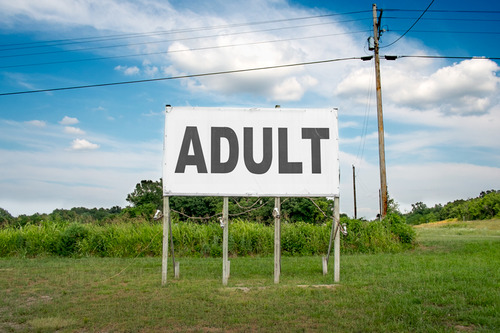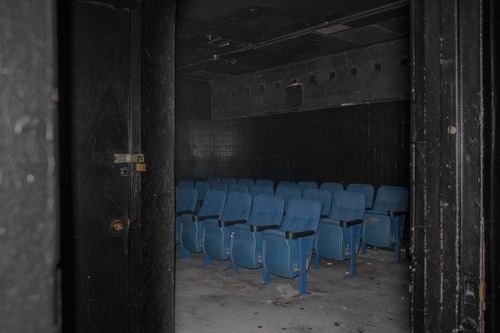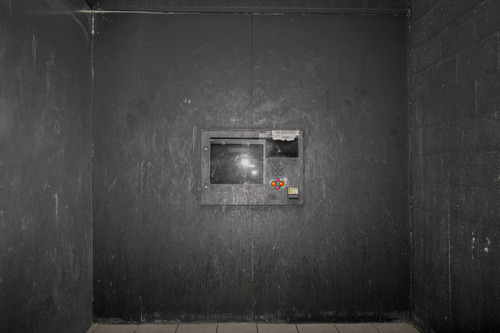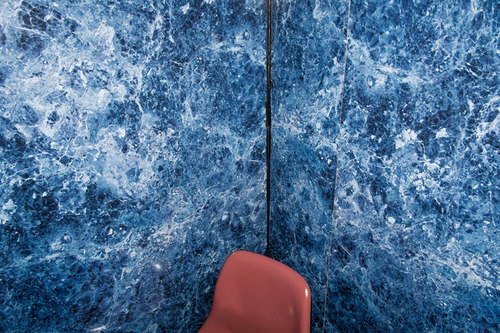
An Interview with Photographer Michael Max Mcleod
Last July, Mike McLeod and I took completely separate photo-centric road trips across the country. I was on my way to Minneapolis for summer camp, and he was headed to New York and back with directions to two hundred adult video arcades—not surprising for Mike. He self-publishes his photographs, which are often rooted in the darkest corners of the male psyche, under the imprint Goodbye Ranch. His zine series Casual Encounters is currently on view at the Witte de With Center for Contemporary Art in Rotterdam as part of an AA Bronson-curated exhibition within an exhibition. The following interview happened in sporadic bursts of text messages over a three-week period after we ran into each other – thanks to social media – on my first night out of town.
—Bucky Miller
I. MEDIEVAL KITSCH
THE BELIEVER: Where are you right now?
MICHAEL MCLEOD: I’m at the Art Institute in Chicago. I just took candy from a Felix Gonzales-Torres sculpture. I’m Instagramming myself pretending to step on Carl Andres and touch Eva Hesses.
BLVR: Why do you keep deleting your Instagram account every few months and making a new one?
MM: I get overwhelmed and delete all of my social media accounts thinking, “That’s it, no more Internet,” but I always come back. Instagram is keeping me company while I drive across the country.
BLVR: I actually re-installed Instagram on my phone for this drive to Minneapolis. I’m glad we both had that impulse, because it let us know we were in Amarillo at the same time. When I saw you there you had just come from photographing a sex shop in an old train car. Do I have that right?
MM: It was sort of unbelievable, you and I ending up in the same Texas town on the same day right across the street from each other. It was an adult video arcade in a converted train station. I never could’ve imagined the ramshackle homemade porn shops I found in Amarillo. Pretty amazing and a little terrifying – converted barns, steel sheds. It’s that porno vernacular I’m after. Lately I’ve been calling it “medieval kitsch.”
BLVR: Medieval kitsch comes through in the photographs. There are times when it looks like you are exploring torture chambers, and the way you are photographing – blasting things with flash – seems like you are investigating crime scenes, but the pictures somehow retain some sensitivity. There’s a lot of fantasy even in the dankest, dirtiest, most hopeless scenes. You told me in Texas that you have two-hundred of these sex shops mapped out on your trip. How much variation is there among these places?
MM: Yes, torture chambers. Or psychological reprogramming labs. There’s this weird parallel with the Internet, too. These video booths are not much more than a chair, a button, a screen, and a way to feed the machine money. They’re all the same in that way, but they’re all different too. There’s definitely a standard-issue video arcade, all of which look the same. But some arcades are so outlandishly different. I get really excited about photographing those.
Legal issues surrounding the arcades differ as well. In some cities, mirrors have to be installed in each booth. In others, the booths can’t have doors; some can only have half-doors. Some have had all the glory-holes sealed over if they were outlawed. These little spaces are definitely contested as far as what a community deems acceptable.
I have mixed feelings about them. Adult video arcades are crushingly sad, the way that video and a hole in the wall has to be a social lubricant for what often goes on between men. But they’re also wonderful social pressure valves. Someone who’s conflicted between culture and desire can find freedom for a dollar.
BLVR: Speaking of the Internet, do you see the work you’ve done with webcams, or meeting men on Craigslist, as leading you to where you are now? Is there a big difference between entering a place unannounced with your camera as opposed to having the situation be pre-arranged and one-on-one?
MM: Yeah, what connects the webcam screen grabs—Casual Encounters—and the adult video arcades is the screen. The screen grabs are about the surface quality of webcam video feeds. With Casual Encounters, the computer screen is a point of access into the real bedrooms of men I meet online. The adult video arcades and porn theater photographs show a type of architecture built around the screen. The work is primarily about the screen, technology and how they’re used to relate—or more accurately not relate, or barely relate—to each other. Sex is just one way into that. It strips everything down to basics.
Each way of working is completely different but they all point back to photography. Making pictures, looking at images, editing them on computers. Using a machine—the camera—as a way of relating to the world.

II. MYSTERY, IMPROVISATION, AND POETRY
BLVR: One of my favorite things about your work is the way that the sexuality is really just a jumping off point to talk about all sorts of stuff. Is technology a lonely thing? Your pictures seem to suggest that it might be.
MM: Maybe the question is: When we use technology to connect with others, is it real? It’s one thing to use digital media to keep in touch with people we already know, it’s another to use the Internet as a world to escape to, to have simulated relationships in. There’s a melancholy in people role-playing sex on webcams or attempting—and failing —to connect with someone on a dating site. Or—as in the case of arcades and porn theaters—to prefer anonymity, to reduce a person to a hole in the wall. It’s way more complex than I can wrap my head around. It is real and it isn’t. The frustration of not being able to understand it is probably what keeps me interested in making these pictures over such a long period of time.
BLVR: You’ve devoted a lot of energy to self-publishing. You are almost finished with the Casual Encounters zine series. Where is that going to end up? What endears you to the zine format?
MM: Growing up in a conservative suburb in Chicago, I would escape with books and magazines. Later, I ended up working for magazines. I designed for Rollingstone.com and produced for Playboy.com. Publishing has always been a big part of my life. When I learned about Printed Matter, a huge world opened up for me. It was a natural progression to publish Casual Encounters as a zine. Printed Matter decided to stock it and through them I connected with a community of artists and publishers around the world. Is it hot where you are? I’m sweaty and suffocating.
BLVR: Yeah. It’s muggy and stupid.
MM: Are you still in Minnesota?
BLVR: I am. This is a hard place to leave.
MM: I’m in Gary, Indiana. It’s beautiful in a sort of America-forgot-about-this-place kind of way. I just made friends with a trucker and hung out in his cab. What are you doing for the rest of the month?
BLVR: I’m not quite sure what I’m doing yet. I’ve been held up in Minnesota.
MM: What is your show called right now? Conversations Around Destroyer?
BLVR: Yes, Conversations Around Destroyer. Really it’s just excerpts from the longer sequence, Destroyer. For this show I wanted to focus on pictures that spoke to one of the primary thought processes going on in the body of work. It was a totally experimental approach to installation that I’m half buying and half not. I think putting “Conversations” in the title was an invitation for people to talk about what the pictures more than anything. I think Destroyer is done now. It was a sequence based on a state of mind, and I’ve exited that state of mind a bit. I feel that it’s time to move on to a new group of pictures.
MM: I like that your photos come from an accident, a place or a state of mind. It’s very free and I envy that. I tend to need a specific project to think about to motivate me to make photographs. But what I think I’m doing is never what I’m doing. It’s something else, and I like the surprise in that, and how it evolves over time. When I see rigid, pre-determined, project-based photography, it’s missing mystery, improvisation, and poetry. What you’re doing is not at all like that. It’s fitting that Catalog of Meteorites is alongside a poem.
With Terrarum I was trying to break out of those defined projects, mix them up and find something complex and new. It’s fun to do that—to crush what I thought I was doing and let what I’ve done become source material for new threads, moods, connections, realizations. Right now I’m in a motel in Toledo eating cold tofu Italian sausages. They succeed more in looking like sausage than tasting like them.
BLVR: That’s an awful picture of sausage.
MM: It’s so awful. I’m going to put it on Instagram and not re-shoot it with a nicer camera. It’s so good next to the trucker pic. The trucker pic looks like a Lee Friedlander nude. The food pics look like Stephen Shore’s American Surfaces, the TV pics also look like Friedlanders, from Self Portrait. I see Baltz, Winogrand, Eggleston. That’s completely my influence – New Topgographics and New Documents. The pics that don’t look like something else are cell phone pics – jogging and motel selfies.
BLVR: Those are influences that you share with a lot of photographers – myself included. What becomes essential is how they mix, both with each other and with the photographer’s personal concerns. I like that you consider the Instagram selfies a part of the larger body. I’ve pretty much delegated Instagram to an outlet for the “this is what I’m doing/look at this funny thing I saw” pictures, so that very personal arc doesn’t creep into my more ‘considered’ photographs. But that’s just me. You maintain a very ambiguous yet palpable personal relationship to all your subjects, so including the self portraits makes sense as another layer to that. Maybe that’s why Terrarum is successful; because it combines all those elements into one succinct thing. The landscape photos, for instance, marinate in the connotations of the other stuff.
MM: I consider most of those photographic influences as being like rock & roll or jazz. The Bechers and Baltz, however, might be analog techno. I respond to the cold analytic quality, the repetition and variation – but not at all in a cool way. For me, it’s a physical rush. I hope my pictures have that technical rush while being human at the same time. I’d like to make pictures that are precise, awkward, funny, dumb and sad all at the same time – a little messy.
Speaking of music, in Chicago during the 90s, I used to go to illegal warehouse parties, make Polaroids, scan them and upload them as the party progressed. People would chat on IRC, listen to an audio stream and look at the pictures. That was a precursor to the dotcom stuff I did later. Music, photography and the Internet have always been closely related for me.

III. I WAS TAUGHT TO RELEASE THE FORM
BLVR: What’s with the questionnaire on American freedom I read about on Facebook?
MM: Missouri was a trip. It seemed like there was either a bible college or a porn shop at every exit. I didn’t even look for shops along the interstate when I was mapping out the trip because it’s the middle of nowhere. I’d see one, get off at the next exit, turn around and check it out. One thing I’ve noticed is that the more conservative a place, the more numerous and elaborate the adult establishments are. Conservatives try to legislate these places out of existence. One way around the legalities is to say that the shop is not so much a store, open to the public, as it is a “private club.” I imagine this lets a shop off the hook legally. In Missouri I had to fill out “membership applications” and pay a “membership fee,” usually a dollar, and get my "lifetime membership card.” I had to sign statements saying I’m not law enforcement and answer questionnaires about the First Amendment, freedom of speech and such. It’s totally a wink-wink-nudge-nudge formality and a little ridiculous.
BLVR: How many stores have you hit so far?
MM: I checked Google Maps, where I have all the locations saved. I’ve been to about 50 porn shops and theaters. It’s all a blur. I’m in Pittsburgh at a super fancy hotel. I lucked out and got it for ridiculously cheap online. It smells like perfume and everyone is cute—in stark contrast to last night, where everything was broken and it smelled like dried pee. Ohio took longer than I anticipated. A handful of the adult shops and porn theaters are in beautiful old decaying buildings. Yesterday in Akron, I waited half a day for a porn theater to empty out so I could photograph it. Today, I did it again in Youngstown, Ohio. There’s a movie theater that opened in 1929. It has a vintage marquee and everything. I was chatting with a guy in his 60s or 70s – the only other person in this massive theater. He said he used to come to the theater when it showed real movies. He also told me that the old lady taking money at what used to be the concession stand bought the theater 15 years ago. When I arrived, I was the only person there and she had to start up the projector, which was a video projector set up on a big black box in the 5th row of the theater. A "MILF” DVD started playing and before each scene the actresses introduced themselves and always made a big deal out of being 40 years old or whatever. It was hard to watch, which is why I was chatting up the old guy, who had shown up a few minutes after me. I went into social engineering mode and tried to flirt with him but he was straight. So I just came out and said, “This place is so awesome. I want to take a picture. Do you think that would be OK?” He told me about a scandal in which a college student recorded people having sex in the theater then posted them online and that I probably shouldn’t. I told him I would never do something like that and then took a picture and left. It’s a nice picture. The old man is all by himself.
Tomorrow I photograph a few places in Pittsburgh then drive to NYC, where I’ll stay for five days. I might just take a break, hang out and read a book. I have a serious case of compassion fatigue. A lot of the clientele are very old men and it’s been bothering me. Yesterday I saw a man almost completely naked in a video booth with an oxygen tank. The hydraulic sound the tank made is haunting me.
BLVR: Is this the first time these places have been so psychologically draining?
MM: It’s just too much in such a condensed period of time. In aggregate it becomes this population across the entire country of old men wandering around in the dark, one hand on their dick and another outstretched to cop a feel.
BLVR: We’ve talked a little in the past about photography’s ability to detach something from its situation while being inextricably linked to it at the same time – about the amazing paradox in that. Is it difficult to maintain that balance when you’re working in such a specific — and potentially taxing — set of locations?
MM: I’m in a "theater” in North Carolina right now. It’s basically a warehouse with seven large makeshift “living rooms,” each with a flat screen TV and couches. It’s like I’m on a set, participating in a demented non-linear TV sitcom. There are three female prostitutes, which explains the unusually high number of straight men milling around. Also, there’s a guy on a couch flipping open a large jackknife repeatedly.
I’m asking myself what attracts me to these places but I haven’t been able to answer that question. It might have something to do with these spaces being a free zone, removed from the world outside. But they’re not that free—they have their own frustrating interior logic.
As I write this, I realize I’m describing Foucault’s heterotopia, “a space of otherness, neither here nor there, both physical and mental.” Which leads back to your question—the paradox of photography. The way this work deals with that question is to feed that paradox back into itself. All of the spaces I’m photographing are designed around the image and exploit our fascination with the screen. Turning these spaces—spaces of otherness—into image hopefully creates a new space of otherness. One in which I can contemplate my relationship with the image.
I was wondering why it’s almost impossible for me to talk about my photography— especially considering I’m a photo history/contemporary art idiot savant. Maybe it has something to do with the urge to break and re-make anything I do—to negate it and push forward. For me, photography is about doing, action, process, looking, feeling. Not about thinking or theorizing. That might come in just a bit at the end to guide an edit. You and I share an annoyance with how people say “photography is a language.” I work as an interpreter and I was taught to "release the form,” that is, disconnect language from what lies beyond in order to communicate it in another language. The process of being in the world with a camera and making pictures is to push against knowledge and be in that pre-lingual, visual place. Everything else—the print, the edit, the book—is outside of that.

Bucky Miller is a photographer and writer.




